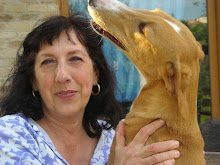Chart Polski : breed standard – commentaries
The general impression of the polish sighthound is that of a robust, working dog, i.e. that the correct specimen should be strong, well muscled and boned. Neither the word “elegant” nor “subtle” are appropriate in describing this sighthound, which was once capable of hunting wolves and deer.
However, the polish sighthound cannot be heavy and stocky. Its general appearance remains a lot of a bigger and heavier saluki, though some differences can be easily seen. The polish sighthound is slightly rectangular – its body length is somewhat bigger than its height at withers. The dog should not be too long, as this usually results in a weak back. Correct length to height ratio enables to efficient and true action. The head of a perfect polish sighthound should be long, lean and narrow. Its typical characteristics are : big and distinctly pointed nose and “roman” muzzle profile (dropping nose). Head planes are not fully parallel. The most common faults are : too narrow and weak underjaw, apple-domed skull, deep frontal furrow, too pronounced cheeks and lack of balance between skull and muzzle. The pigmentation should follow coat colour. When it is diluted (i.e. blue or fawn), the pigmentation is also blue or fawn, respectively. In case of a very pale ivory colour, the nose might be also extremely light. However, pink or spotted (butterfly) nose is definitely faulty. Eyes are rather large, almondshaped, oblique and generally similar to those of saluki, yet the expression is distinctly sharp. Both too small and large, round eye is faulty. The neck is long, strong and well muscled. It is set lower than this of a greyhound, but higher than that of a borzoi. So called “ewe neck”, usually accompanied with upright shoulder, is a common fault with the breed. Quite often, inexperienced handlers tend to pose their dogs with heads carried as high as possible, what is definitely wrong.
BODY
The withers of the polish sighthound are only slightly pronounced and they are never as distinct as those of an afghan hound. The topline is slightly arched in loins. Sometimes this arch is too strong, and this fault usually goes together with lack of angulation both in front and hindquarters. Perfectly level topline can be seen with some bitches, and is not considered faulty. The chest must be deep, and it is not too flat – too flat and too shallow chest is a common fault. This happens often when a growing youngster has not been provided with
good exercise. The sternum is rather long, but sometimes it is too short, almost as short as that of an azawakh. In such case both the shoulder and the upper arm are too straight. Tail is usually carried low and may be even hanging loose. When the dog is moving, its tail is carried higher and forms a sabre or a ring. No matter how high is the end of the tail, its base should be always in line with the back – otherwise the tail is faulty. The tail is well feathered with longer, dense and harsh coat. Featherings cannot be long and soft. The muscles of the polish sighthound are not as fleshy as those of a greyhound – they are very dry and flat. This is typical of a long distance runner. The hindquarters are – when viewed from behind – rather narrow, both in stance and in action. With increased speed, its action is distinctly single-tracked. This single track is a typical characteristic of the breed, and should never be considered faulty. The coat differs the breed from other sighthounds – it is dense and harsh, with good undercoat. Its length varies on different parts of the body. The coat should not resemble that of a greyhound or a borzoi.
good exercise. The sternum is rather long, but sometimes it is too short, almost as short as that of an azawakh. In such case both the shoulder and the upper arm are too straight. Tail is usually carried low and may be even hanging loose. When the dog is moving, its tail is carried higher and forms a sabre or a ring. No matter how high is the end of the tail, its base should be always in line with the back – otherwise the tail is faulty. The tail is well feathered with longer, dense and harsh coat. Featherings cannot be long and soft. The muscles of the polish sighthound are not as fleshy as those of a greyhound – they are very dry and flat. This is typical of a long distance runner. The hindquarters are – when viewed from behind – rather narrow, both in stance and in action. With increased speed, its action is distinctly single-tracked. This single track is a typical characteristic of the breed, and should never be considered faulty. The coat differs the breed from other sighthounds – it is dense and harsh, with good undercoat. Its length varies on different parts of the body. The coat should not resemble that of a greyhound or a borzoi.
Malgorzata and Izabella Szmurlo
